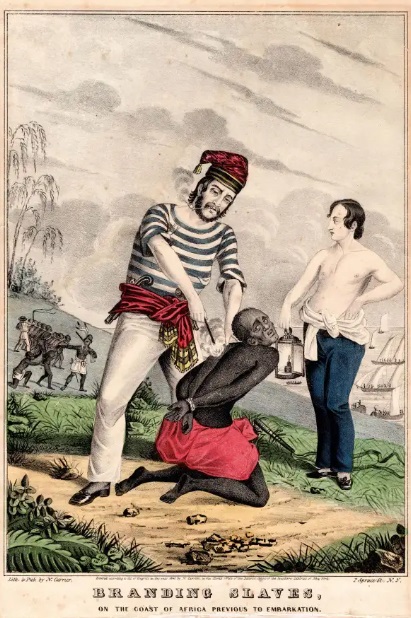
A series of pages exploring
various aspects of enslavement in Pennsylvania
Images of Enslavement
Commercial Images

"Branding Slaves on the Coast of Africa Previous to Embarkation," by Nathaniel Currier, 1845.
Notes
Nathaniel Currier (1813-1888) was apprenticed at age 15 to the lithography firm of William S. and John Pendleton of Boston, Massachusetts. After learning the trade, he moved to Philadelphia and later to New York, where in 1835 he began to produce lithographs of scenes from everyday life in America. He gained fame with the production of a print, based upon a scene by artist W. K. Hewitt, depicting the burning of the steamship Lexington in Long Island Sound in 1840.
Currier's prints were inexpensive--most cost between fifteen cents and three dollars each--allowing average Americans to be art collectors. The images were mass produced by artists working for Currier, and the company produced an average of three new titles per week over a sixty year period. In 1852 a savvy businessman named James Merritt Ives joined the company and introduced several marketing innovations, including catalogue showrooms and door-to-door sales. In 1857 Ives became a partner, and after that the images bore the company name Currier & Ives.
The most popular prints produced by the company were images that showed an idealized version of antebellum America: small, middle-class, prosperous families in a rural/agricultural environment. Currier's prints appeared at about the same time that Americans were adding a fashionable new room to their homes--the parlor--which required tasteful furnishings and decor. Other prints were produced for specific audiences, depicting such subjects as temperance, moral lessons, religious themes, comic scenes, and politics.
The subject of the print Branding Slaves was rare in that it portrayed an atrocity. Abolition, in 1845, was still a controversial topic in America. This print, however, was popular because it side-stepped the moral issues and showed the system at its most brutal, and was therefore condemnable by all. Horrors of the slave trade were clearly depicted by details in the print: the fear and horror on the face of the African prisoner, contrasted with the bored expressions of the slavers; the bullwhip lying on the ground behind the slaver to the right; the pistol stuck into the sash of the man with the branding iron; the smoke from the branding iron as it sears the African man's flesh; groups of slaves in coffles, in the left background; and near that a slave being torn from the grasp of a friend or family member. These are all images designed to arouse disgust and revulsion against the most violent aspects of slavery. Not addressed, however, are the moral issues which were central to the actual debates over the institution at the time.

The Currier image, produced in 1847, is an obvious reworking of an earlier
image Branding a Negress, a British print from about 1820, which was in turn taken from Auguste Francois Biard's painting The Slave Trade, shown above. Currier changed the sex of the slave to a male and added several years to
the age of the young boy holding the lantern. The image of the
slaver with the brand is much closer to the original image, except that
Currier changed his facing along with that of the slave.
Another popular contemporary image depicting a semi-nude female slave is
more modest, with the slave's arms crossed over her chest. Also, the young boy in the original image is gazing directly at the slave,
whereas in Currier's image he not only appears older, but is looking
away. Currier's image, produced for an American consumer, is
less powerful than its British antecedent, despite the details added by
the artist to make up for the changes. It almost seems as if this original image was too lurid for Currier,
even if it's intent was to arouse sentiment against the cruelties of the
slave trade.
It almost seems as if this original image was too lurid for Currier,
even if it's intent was to arouse sentiment against the cruelties of the
slave trade.

